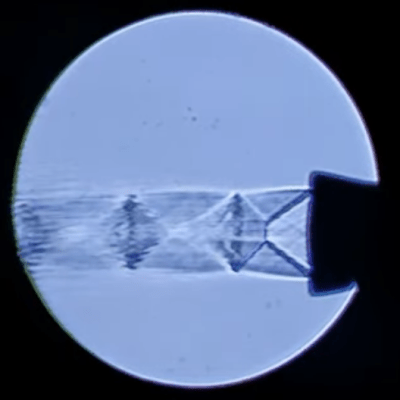We’re suckers here for projects that let you see the unseeable, and [Ayden Wardell Aerospace] provides that on a budget with their $30 Schlieren Imaging Setup. The unseeable in question is differences in air density– or, more precisely, differences in the refractive index of the fluid the imaging set up makes use of, in this case air. Think of how you can see waves of “heat” on a warm day– that’s lower-density hot air refracting light as it rises. Schlieren photography takes advantage of this, allowing to analyze fluid flows– for example, the mach cones in a DIY rocket nozzle, which is what got [Ayden Wardell Aerospace] interested in the technique.

While it is possible that [Ayden Wardell Aerospace] has technically constructed a shadowgraph, they claim that carefully positioning the smartphone allows the sharp edge of the case to replace the razor blade. A shadowgraph, which shows the second derivative of density, is a perfectly valid technique for flow visualization, and is superior to Schlieren photography in some circumstances– when looking at shock waves, for example.
Regardless, the great thing about this project is that [Ayden Wardell Aerospace] provides us with STLs for the mirror and smartphone mounting, as well as providing a BOM and a clear instructional video. Rather than arguing in the comments if this is “truly” Schlieren imaging, grab a mirror, extrude some filament, and test it for yourself!
There are many ways to do Schlieren images. We’ve highighted background-oriented techniques, and seen how to do it with a moiré pattern, or even a selfie stick. Still, this is the first time 3D printing has gotten involved and the build video below is quick and worth watching for those sweet, sweet Schlieren images.

















I can see a smartphone Schlieren setup being able to avoid using an external stop just by the entrance pupil for the camera being so danged tiny to start with.
Now I could be wrong but I think the knife edge of a Schlieren is intentionally asymmetric across the pupil plane and this is what yields an image which is more sensitive to changes in the first derivative along the axis of the edge at the expense of intensity/exposure/noise. The edge/stop is blocking light but only in one direction which yields a characteristic image which is darker on one half than the other.
Shadowgraphs have always been able to use cameras or even photographic film with or without a stop. It’s just a less ‘specific’ operating principal.
I agree with the reporting here, this is a shadowgraph. That doesn’t make it any less awesome though.
Please don’t use term ‘ weaponizes’ unless someone is using something as a weapon. This is an extremely poor choice of words, and makes no sense. I Schlieren photography utilizes that observation.
+1
don’t actually know anything about razors but i just realized i’ve done this… take my 6″ reflector telescope out on a cold night and have it just a little out-of-focus and you can see every waft of hot air coming off of it as it cools. once the aparatus has cooled off, i can hold my hand just below the aperture and watch the hot air come off my hand
You can do this with a spotting scope when shooting to read the wind.
Thats a serious tip!
I wonder if this kind of setup could be used as a cheap alternative to detect overheating faulty component (shorted for example) on a PCB, instead of using a rather expensive thermal camera?
probably hard to pull up with any precision, but yes. you can get cheap thermal cam for not a lot nowaday. there’s plenty of sub 100$ options now, including some 240×240 /25hz model